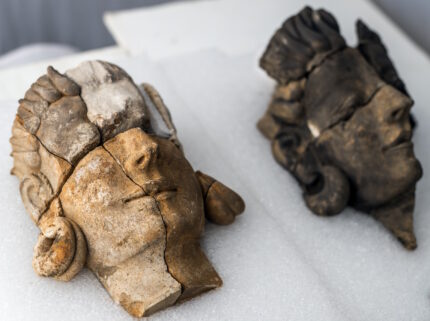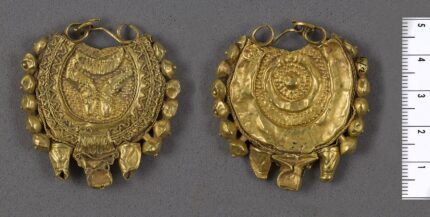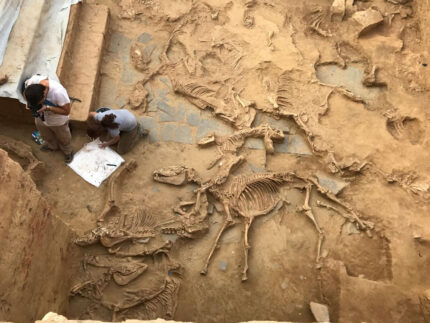 An excavation at the Bronze Age site of Casas del Turuñuelo in western Spain’s Badajoz province has unearthed the first figural representations of human faces from the Tartessian culture (8th-4th century B.C.). Archaeologists discovered five figural reliefs dating to the 5th century B.C. Two of them are almost complete and depict female faces wearing large hoop earrings typical of Tartessian goldsmithing. The other three are fragmentary, but part of a helmet on one of them identify it as a warrior figure.
An excavation at the Bronze Age site of Casas del Turuñuelo in western Spain’s Badajoz province has unearthed the first figural representations of human faces from the Tartessian culture (8th-4th century B.C.). Archaeologists discovered five figural reliefs dating to the 5th century B.C. Two of them are almost complete and depict female faces wearing large hoop earrings typical of Tartessian goldsmithing. The other three are fragmentary, but part of a helmet on one of them identify it as a warrior figure.
The Tartessos civilization was a Bronze Age culture of Southern Iberia. At its greatest influence, Tartessos settlements spread through what are now western Andalusia, Extremadura and southern Portugal. Some ancient sources, including Herodotus, refer to Tartessos being an important city on the coast of Spain known for its metalwork and strong cultural and trading ties to the Phoenician colonies in the region.
 The Phoenician influence on the Tartessians is seen in the archaeological material. The first evidence of the Tartessian language were inscriptions found in a Phoenician necropolis in the 1920s. Ornate metal objects — gold jewelry, belt buckles, diadems — found in Tartessian contexts such as the exceptional Aliseda Treasure found in Cáceres, display the Phoenician techniques of granulation, filigree and welding as well as Phoenician deities and imitation Egyptian motifs that were big sellers for Phoenician traders in luxury goods during the Orientalizing Period (8th-7th centuries B.C.).
The Phoenician influence on the Tartessians is seen in the archaeological material. The first evidence of the Tartessian language were inscriptions found in a Phoenician necropolis in the 1920s. Ornate metal objects — gold jewelry, belt buckles, diadems — found in Tartessian contexts such as the exceptional Aliseda Treasure found in Cáceres, display the Phoenician techniques of granulation, filigree and welding as well as Phoenician deities and imitation Egyptian motifs that were big sellers for Phoenician traders in luxury goods during the Orientalizing Period (8th-7th centuries B.C.).
Most Tartessian sites are settlements and tombs. Casas del Turuñuelo is an architecturally innovative sanctuary that is unique on the Tartessian archaeological record. The reliefs were found on the eastern entrance of the site leading into the courtyard where the remains of a large-scale animal sacrifice (16 horses, two bulls and one pig) were found in 2017. It is the largest mass sacrifice of animals documented in the ancient western Mediterranean, an expensive offering to the gods to seal the temple before its deliberate destruction.
 The sanctuary’s reliefs of female figures are not only the first figural depictions of Tartessian people, they are also the first depictions of Tartessian gold earrings, previously only known from archaeological finds like the Aliseda Treasure. Archaeologists believe the quality and detail in the reliefs indicate they are representations of female deities, although they could also be aristocratic women.
The sanctuary’s reliefs of female figures are not only the first figural depictions of Tartessian people, they are also the first depictions of Tartessian gold earrings, previously only known from archaeological finds like the Aliseda Treasure. Archaeologists believe the quality and detail in the reliefs indicate they are representations of female deities, although they could also be aristocratic women.
This extraordinary finding represents a profound paradigm shift in the interpretation of Tartesus, traditionally considered an aniconic culture for representing divinity through animal or plant motifs, or through betyls (sacred stones). Lastly, the finding only further influences both the importance of the site and the importance of the Tartessian culture in the Guadiana valley during its last moments.
The “Dama de Baza” is a famous example of Iberian sculpture by the Bastetani. It is a limestone female figure with traces of painted detail in a stuccoed surface.
The Bastetani (or Bastuli) were an ancient Iberian people of the Iberian peninsula. The relationship between the Bastetani and the Tartessian Mastieni (who lived in Mastia) is not entirely clear.
The “Dama de Elche” would be yet another example of female Iberian sculptures with jewellery and Phoenician and also (Pre)-Hellenistic influences.
OK. How far they are “Tartessian”, could indeed be a matter of debate. However, as far as the Bronze Age is concerned:
“Tarshish”, Greek: Θαρσείς, occurs in the Hebrew Bible, most frequently as a region far across the sea from Phoenicia (Lebanon) and the Land of Israel. Tarshish is said to have exported vast quantities of important metals to Phoenicia and Israel. The same place-name occurs in the Akkadian inscriptions of Esarhaddon (the Assyrian king) but also on the late 9th century BC “Nora Stone” in Sardinia.
—–
According to Herodotus, 1.163: ..Now these Phocaeans [from what is now Turkey] were the first of the Hellenes who made long voyages, and these are they who discovered the Adriatic and Tyrsenia and Iberia and Tartessos: and they made voyages not in round ships, but in vessels of fifty oars. These came to Tartessos and became friends with the king of the Tartessians whose name was Arganthonios..